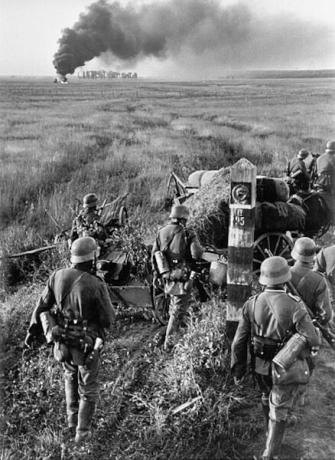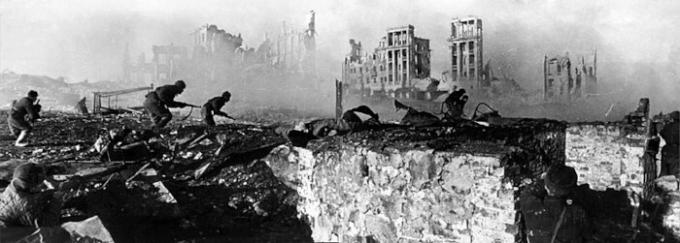To the main battles of World War II they were:
- Saar Offensive;
- Air Battle of Berlin;
- Battle of Arnhem;
- Battle of Sedan;
- Battle of Britain;
- Normandy landings (“D-Day”);
- Operation Varsity;
- Battle of Stalingrad;
- Battle of Monte Castello;
- Battle of Castelnuovo.
Prominent among these are the Battle of Stalingrad and the Battle of Normandy. The Battle of Stalingrad took place in August 1942, in the Soviet Union: German troops arrive at the city of Stalingrad and fight one of the most important battles of the Second War, with victory soviet. The Battle of Normandy was the first step in Operation Overlord, which began on June 6, 1944 (the so-called “D-Day”), and consisted of the landing of more than 3 million Allied soldiers in the French territory of Normandy.
Read too: Battle of the Ardennes — Last Nazi Offensive of World War II
Summary of the main battles of World War II
- The main battles of World War II were: Saar Offensive, Air Battle of Berlin, Battle of Arnhem, Battle of Sedan, Battle of of England, Normandy Landing (“D-Day”), Operation Varsity, Battle of Stalingrad, Battle of Monte Castello and the Battle of Castelnuovo.
- The Battle of Stalingrad and the Battle of Normandy stand out for their strategic importance.
- The Battle of Stalingrad took place in August 1942, in the Soviet Union: German troops arrive at the city of Stalingrad and fight one of the most important battles of the Second War, with victory soviet.
- The Battle of Normandy was the first step in Operation Overlord, which began on June 6, 1944, the so-called “D-Day”, and consisted of the landing of more than 3 million Allied soldiers in the French territory of Normandy.
- The biggest and bloodiest battle of World War II was the Battle of Stalingrad: on the German side, more than 800,000 men were killed or wounded; on the Soviet side, more than 1.1 million.
- The consequences of these two great battles were the beginning of the Allied counter-offensive against Nazi Germany and its defeat in the war.
List of major battles of World War II
- Saar Offensive (September 7-16, 1939): Nazi Germany invades France and defeats French troops.
- Berlin air battle (November 18, 1943 to March 31, 1944): The Allied Countries, commanded by the Air Force British, invade Berlin airspace and bomb the city, but are expelled by the Air Force Nazi.
- Battle of Arnhem (September 17-26, 1944): British and Nazi troops clashed in the Netherlands, resulting in German victory and occupation of the region.
- Battle of Sedan (May 12-15, 1940): Nazi troops consolidated their hold on France, defeating both French and British troops.
- battle of britain (September 15, 1940): Nazi military air force invades British airspace and engages in battle with the British air force, which prevails and repels the German invasion.
- Normandy landings (“D-Day”: June 6, 1944): Allied troops, mainly from the US, England and Canada, begin the counter-offensive that would liberate France and face the Nazis in Europe.
- Operation Varsity (March 24, 1945): US and British paratroopers invade German territory with thousands of aircraft, reinforcing troops on the ground.
- Battle of Stalingrad (August 23, 1942 – February 2, 1943): The Nazi invasion of the USSR culminates in the battle against the Soviet armies, which defeat Germany and initiate the Eastern Front.
- Battle of Monte Castello (November 25, 1944 – February 21, 1945): Brazilian troops from the Brazilian Expeditionary Force (FEB) and Americans confront the Nazi German army in Italy and liberate the region.
- Battle of Castelnuovo (March 5-6, 1945): Brazilian FEB troops face and defeat Nazi troops in the city of Castelnuovo, Italy.
See too: What were the causes of World War II?
What were the main battles of World War II?
World War II (1939–1945) was the largest worldwide military conflict in history, claiming millions of human lives. Among the many important battles of that war, two stand out with strategic importance:
- Battle of Stalingrad, culmination of Operation Barbarossa;
- Battle of Normandy, part of Operation Overlord.
→ Battle of Stalingrad
Between 1939 and 1943, Nazi Germany conquered territories and won battles in World War II. Much of Europe had already been conquered by the Nazis, and apparently they were winning the war. The scene began to change when Hitler decided to break the non-aggression pact signed with the Soviet Union and invade its territory., event known as Operation Barbarossa, which took place between June and December 1941.

In the years following the start of the invasion, the nazi army advances with the most numerous troops in the military history of the world, with more than 4 million soldiers who, despite the numbers and the equally impressive amount of equipment, are advancing with difficulty on Soviet territory.
The Soviets were able to delay the German advance through military strategies, tactics such as "land razed” (which consists of abandoning localities, burning constructions and structures) and, not least, the rigor of the winter. In August 1942, the German troops meet Soviet troops in the city of Stalingrad and fight one of the most important battles of World War II. in it, the Soviets managed to defeat the Germans and starting the first counter-offensive against the Axis, which irreversibly changed the course of the war.
→ Battle of Normandy
On the other side of the continent, on the Western Front, in 1944, the Allies were organizing a strategy to invade the Europe, liberate France (under Nazi occupation since 1940) and launch a new counter-offensive against Germany Nazi. The Battle of Normandy was the first step in Operation Overlord, beginning on June 6, 1944 (the so-called "D-Day"), what consisted of the landing of more than 3 million Allied soldiers in French territory from Normandy.

This coastal region was occupied by Nazi troops, and the confrontation between these forces was named the Battle of Normandy, occurred between June 6 and August 30, 1944.
What was the bloodiest battle of WWII?
The biggest and bloodiest battle of World War II was the Battle of Stalingrad, which took place between August 23, 1942 and February 2, 1943. On the Axis side, soldiers from Germany, Italy, Romania, Croatia and Hungary fought against troops from the Soviet Union.

The battle begins in August with 270,000 Axis troops against 187,000 Soviet troops, numbers that grow to 1 million Axis troops against 1.8 million Soviet troops in November. The battle It is considered the bloodiest of the war due to the number of dead and wounded.: on the German side, more than 800 thousand; on the Soviet side, more than 1.1 million.
Consequences of the main battles of World War II
- Aftermath of the Battle of Stalingrad: one can point to the beginning of the Soviet counter-offensive against the Germans and the turn of the tides of war, which from then on walked towards the Nazi defeat.
- Aftermath of the Battle of Normandy: one can point out the landing of millions of Allied soldiers, the liberation of France, the opening of a new Allied counter-offensive in Europe that reinforced the tendency of Nazi defeat and culminated in the end of the war.
image credits
[1]RIA Novosti Archive, image #44732 / Zelma / CC-BY-SA 3.0/ Wikimedia Commons
Sources
ALMEIDA, Angela Mendes. The Weimar Republic and the Rise of Nazism. São Paulo: Brasiliense, 1990.
HOBSBAWN, Eric. The Age of Extremes: the short twentieth century (1914–1991). São Paulo: Companhia das Letras, 1995.
MASSON, Philippe. The Second World War: History and strategies. São Paulo: Context, 2010.
Source: Brazil School - https://brasilescola.uol.com.br/historiag/principais-batalhas-da-segunda-guerra-mundial.htm
